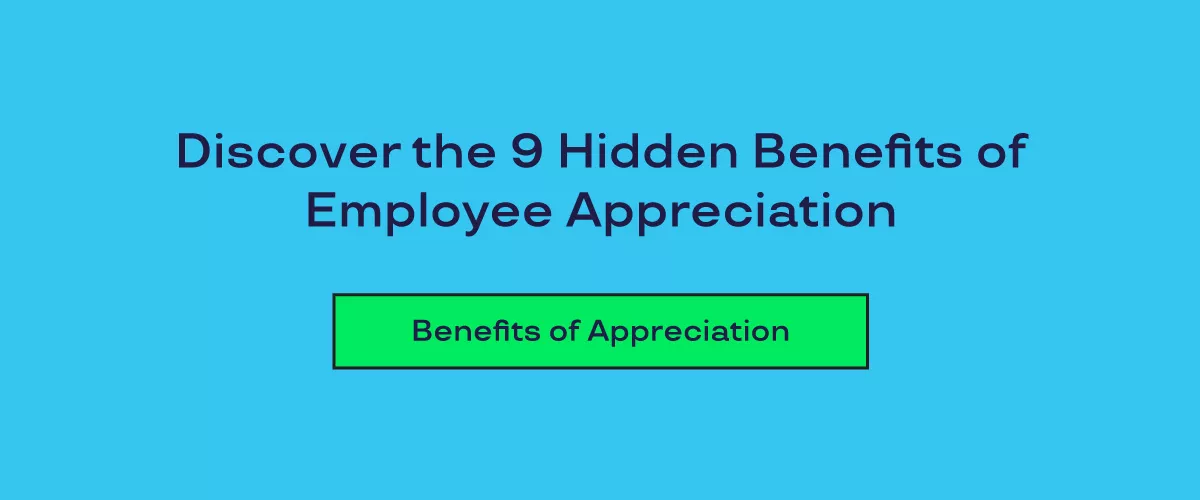
How Employee Appreciation and Recognition Impact Retention
January 19, 2024
With talent pools becoming increasingly competitive due to workplace flexibility, organizations are now realizing that traditional retention methods alone won't suffice.
To retain top talent in today's modern workforce, organizations must create a positive workplace culture that supports, empowers, and satisfies their valuable employees.
Fortunately, there are innovative ways to retain top talent, including robust employee appreciation and recognition programs. These programs not only boost morale and job satisfaction but also strengthen the relationship between employees and their organizations, fostering long-term loyalty.
This blog post reveals how appreciation and recognition impact employee retention and the best recognition programs you can use to mitigate turnover.
What are employee recognition and appreciation?
Before diving into the impact of employee recognition and appreciation on retention, let's first define these terms.
Employee appreciation involves showing gratitude and acknowledging the efforts and contributions of employees. Recognition, on the other hand, is about acknowledging specific achievements, skills, or qualities of employees in a public or private manner. In the workplace, this might translate to spot awards, peer-to-peer recognition programs, and service anniversary recognition, among other things.
Essentially, employee appreciation revolves around general gratitude, while recognition involves celebrating employees' accomplishments.
What is retention?
As Gartner defines it, employee retention involves the "organizational policies and practices that are designed to encourage employees to remain employed by a company." It involves investing in your employees and enhancing their experience with your organization to reduce their chances of leaving.
A couple of strategies organizations use to retain their employees include:
-
Offering career growth and development
-
Implementing a robust onboarding program
-
Providing competitive compensation
-
Recognizing their employees' hard work and dedication.
The Cost of Turnover
High turnover rates can be expensive for organizations – and often, they can be hidden costs! The cost of recruiting, onboarding, and training new employees can add up quickly. The average cost per new hire is roughly $4,700, according to SHRM. However, SHRM also reports that the total cost can be nearly three to four times the position’s salary, with 30-40% being hard costs.
Additionally, a high turnover can disrupt team dynamics and reduce overall efficiency within the organization. A new hire can take six to twelve months to ramp up and feel confident in their new role. They may need to learn new skill sets, processes, and tools for their new position. During that ramp-up period, new hires aren’t as productive or efficient, causing projects to drag on.
Not sure what the cost of turnover is for your organization? Find out what it is with our calculator.
The Impact Appreciation and Recognition Have on Retention
Now that we understand these concepts, let’s explore how appreciation and recognition positively affect retention.
Employee appreciation and retention go hand-in-hand. When employees' hard work is acknowledged and recognized, their morale and job satisfaction soar, leading to higher retention rates. In fact, studies show that employees who are recognized are nearly 6x more likely to stay at their jobs than those who aren’t.
Here’s how meaningful recognition drives retention:
Boosts Morale
When employees feel appreciated and recognized for their contributions, it boosts their morale. This leads to increased job satisfaction and a stronger sense of belonging within the organization, which drives employee loyalty.
Recognizes the Moments that Matter Most
Employee recognition programs empower organizations to acknowledge and recognize the big milestones in an employee’s career. These moments, when celebrated thoughtfully, are memorable and encourage employees to stay committed to their roles.
Increases Job Satisfaction
Recognized and appreciated employees are more likely to be satisfied with their jobs. Job satisfaction is a key driver of retention, as content employees are less inclined to seek opportunities elsewhere.
Fosters Belonging
Employees who feel valued and appreciated typically have a stronger sense of purpose and belonging within an organization. Recognizing employees’ hard work and contributions can strengthen their ties with the company, which makes them less likely to look for external job opportunities.
Employee Appreciation and Recognition Program Examples
While some turnover is inevitable, you can take precautions and avoid high turnover costs by cultivating a positive and supportive organizational culture. A comprehensive employee appreciation and recognition program can help you in this mission. Such programs encourage employees to celebrate each other’s accomplishments, elevating team morale and increasing retention.
Looking for practical ideas to implement within your organization? Consider implementing the following effective appreciation and recognition strategies:
- Employee of the Month Awards: Recognize employees who exhibit the company’s values and go above and beyond on a monthly basis. This type of program encourages and motivates employees to perform their best by singling out individuals who consistently have outstanding performance.
- Peer Recognition Platform: Implement an employee recognition platform like Inspirus Connects where employees can acknowledge and appreciate their colleagues’ efforts. Peer recognition, when encouraged, cultivates a culture of appreciation from within the organization.
- Personalized Thank-You Notes: In the digital age, a traditional handwritten note can go a long way in making employees feel valued. Encourage managers and peers to express their gratitude through writing personalized thank-you notes for achievements, partnership, and attitude.
- Blank Recognition Cards: Do your employees work hybrid or full-time in the office? Leave a box of blank cards on each floor and encourage employees to write recognition notes often. This is a great option for a cost-effective and informal recognition strategy.
- Nomination Programs: Encourage employees to actively participate in the recognition process. Nomination programs involve employees nominating their colleagues for recognition based on specific criteria or accomplishments.
Conclusion
Employee appreciation and recognition programs play a crucial role in improving retention rates - and reducing turnover costs - within organizations. By cultivating a culture of recognition, organizations can improve satisfaction and morale, driving employee loyalty.
Ultimately, investing in employee appreciation and recognition is an investment in the long-term success of your organization.





